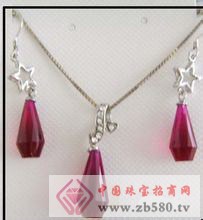Corundum identification
Dyeing treatment The corundum with shallow color and fissure development is placed in a colored dye solution to be soaked and heated to make it color. Identification: 1. The dye is concentrated in the crack during the magnification inspection. 2. Although the appearance is rich, there is no obvious pleochroism. This is because the dye does not enter the crystal lattice of the gemstone. 3. Dyes may cause abnormal fluorescence, such as orange-orange-red fluorescence. 4. The absorption peak of the dye appears in the infrared spectrum. Filling treatment Fill the cracks or voids of the ruby ​​with oil, glue, glass, etc. to cover these flaws. Identification: 1. When the oil-treated ruby ​​is enlarged, it can be found that there is a colorful interference color in the crack, and when some oil is volatilized, it can leave marks and slag-like precipitates. The hot needle can be exposed to oil beads. 2. The luster of the gypsum-treated ruby ​​crack is significantly lower than that of the ruby ​​body, and the crack is large. The tip of the needle can be used to swipe the glue inside. The absorption peak of the gel appears in the infrared spectrum. 3. The glass-filled ruby ​​is often developed with cracks, the gloss of the glass in the crack is significantly lower than that of the ruby ​​body, and the glass plane filled in the large crack is often sunken. Sometimes it is visible that bubbles have not escaped. Heat treatment This method has a long history and its results are stable and long-lasting and are generally accepted. Mainly used in: 1. Cut blue: Heating a blue-toned ruby ​​or dark sapphire in a high-temperature oxidizing atmosphere will cause a conversion of Fe2+ to Fe3+, which will reduce the amount of Fe2+/Ti4+-induced ion pairs in the sample, thereby removing excess blue. This method also turns pale yellow, yellow-green samples into orange or golden yellow. 2. Deepen or induce blue: The light-colored sapphire is heated in a high-temperature reducing atmosphere, and the original Fe3+ in the gemstone is converted into Fe2+, which increases the number of pairs of Fe2+/Ti4+-induced ions, so that the sample becomes shallower and deeper. 3. Remove the filamentous inclusions: Rubing ruby ​​or sapphire to 1600-1800 ° C in the air, melting the rutile (TiO2) originally in the form of filaments and needle-like inclusions, and then rapidly cooling, so that the titanium enters the crystal lattice and forms a solid solution with Al2O3, thereby Achieve the purpose of improving clarity. 4. Produce starlight: The sample is heated in air and then slowly cooled to melt the titanium present in the sample as a solid solution to form a rutile needle-like inclusion, thereby producing starlight. 5. Healing fissures: The ruby ​​which develops a large number of cracks is heated in sodium borate, and since the sodium borate can lower the melting point of the ruby, the crack is healed. Identification of heat treatment: 1. The color appears unevenly diffused halo or color patches. 2. The low-melting inclusions (such as feldspar, calcite, apatite, etc.) contained inside are partially melted, which makes the edges of the original columnar crystals smooth. Some filamentous, needle-like inclusions (such as rutile) become intermittent filaments and spots. 3. The native fluid inclusions inside the sample burst under high temperature and the fluid is immersed in the newly cracked crack. 4. The surface of the cut sample will be partially melted, resulting in some uneven pits. In the second polishing performed to eliminate the pits, double waist and multi-faced waist are often observed. 5. Yellow and blue sapphire produced by heat treatment lacks a 450 nm absorption band. Surface diffusion treatment The colored ions enter the surface lattice of the light or colorless sample at a high temperature to form a thin colored diffusion layer. Its thickness is generally 0.004-0.4 mm. When using Cr as a coloring agent, a red diffusion layer can be produced; when Fe or Ti is used as a coloring agent, a blue diffusion layer can be produced; and Cr, Ni as a coloring agent can produce an orange-yellow diffusion layer. Identification: 1. When the sample was immersed in diiodomethane, it was observed that the color was concentrated in the waist circumference, the facet edge and the open crack. 2. In the short-wave ultraviolet light, the surface-diffused sapphire can be seen in white-like blue or green fluorescence, while the surface-diffusing ruby ​​can be seen in plaque-like blue-white phosphorescence. 3. The surface diffusion treated ruby ​​has an abnormal refractive index and a refractive index of up to 1.80. 4. The surface diffusion treated sample is dichromatic, and the red variety sometimes exhibits an abnormal yellow-brown yellow dichroism. 5. The starlights produced by surface diffusion treatment have perfect and uniform star lines, which are similar to synthetic starlight species. However, under the microscope, it can be found that "starlight" is limited to the surface of the sample. Moreover, there are no three groups of aligned rutile fine needles in the natural star species, only the surface is composed of a very thin layer of flocs, which are gathered by tiny white spots. SHAOXING SKYRISE TEXTILE CO.,LTD , https://www.eurofashiontextile.com